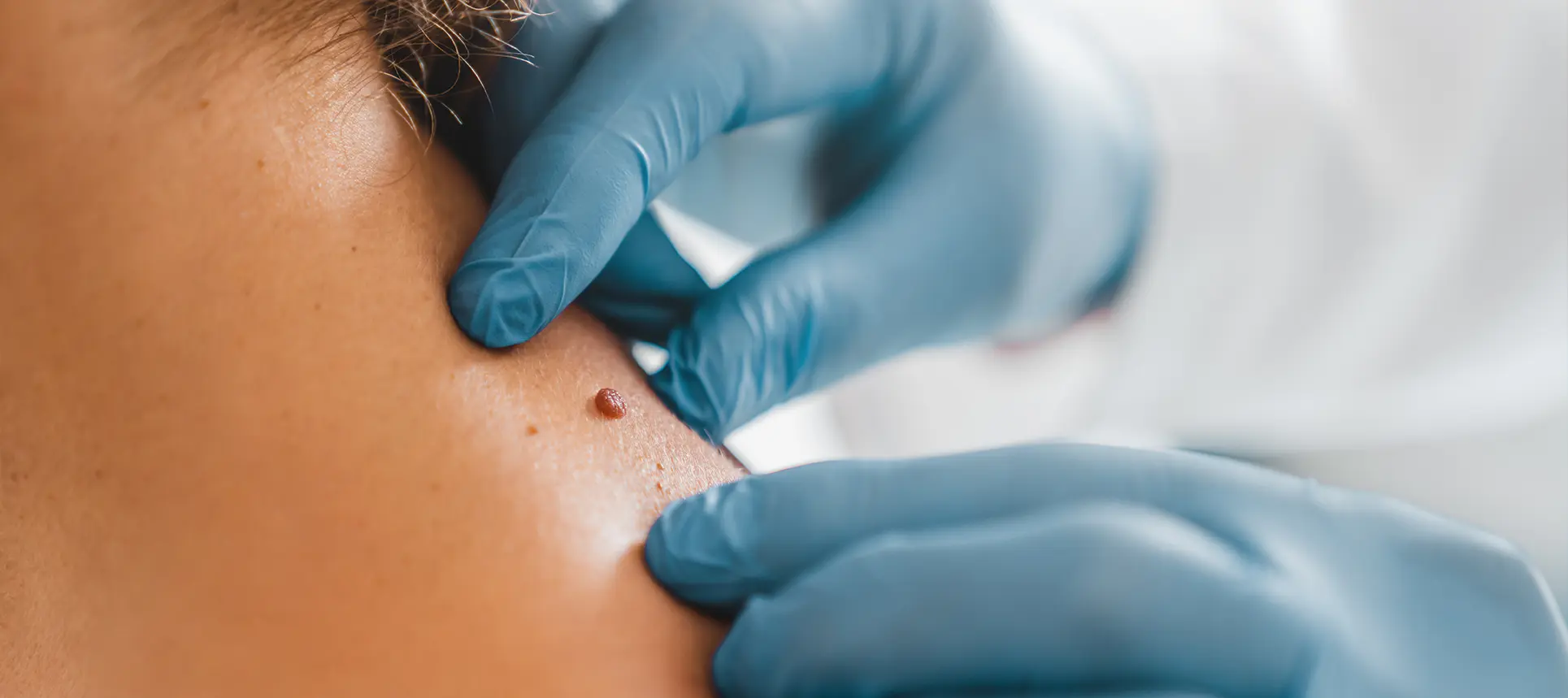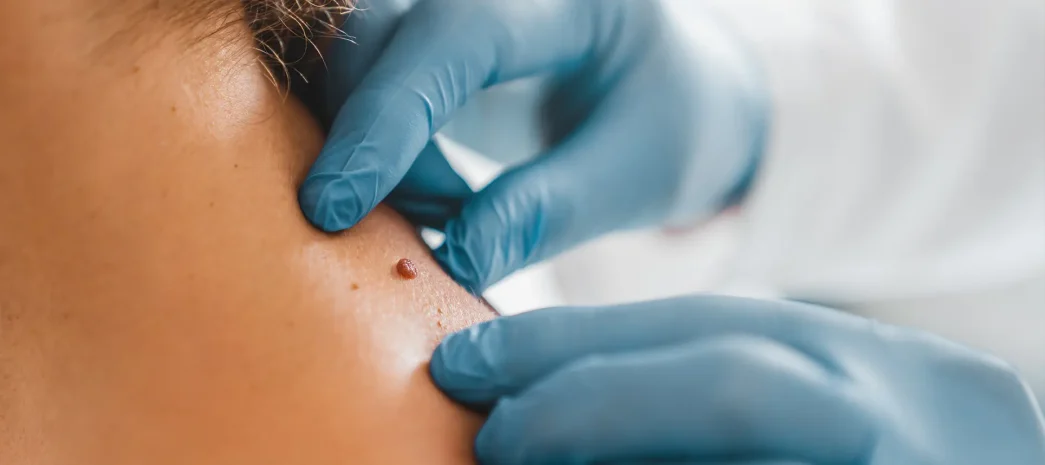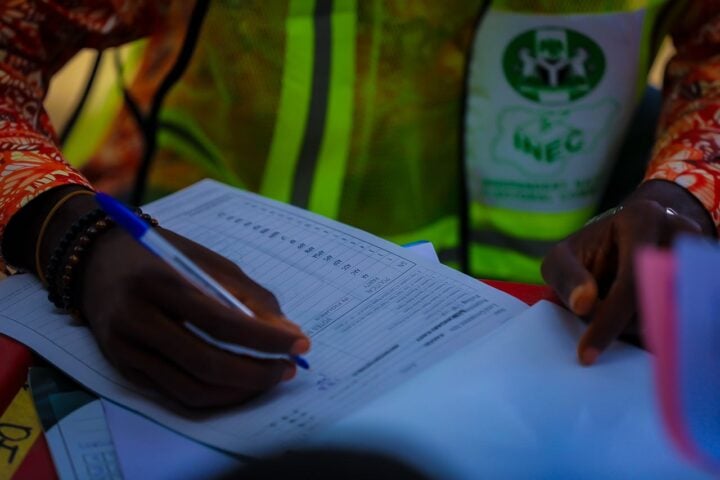Skin tags are a very common phenomenon, with about half of all adults expected to develop at least one in their lifetime. The likelihood of developing them increases with age, with a notable rise after the age of 40.
Also known as acrochordons, skin tags are small, benign growths of skin that typically appear in areas where the skin folds. They are soft, flesh-coloured or slightly darker growths that sometimes hang off the skin by a stalk and are composed of collagen fibres, blood vessels, and skin. They are often harmless, noncontagious and usually do not cause pain. They may, however, become itchy, irritated, or bleed if they rub against clothing, jewellery, or other skin.
Skin tags can be categorised based on different factors, including size, appearance, and location. Based on size, they are typically 1-2 millimetres in width and height and are often found on the neck and armpits; mid-sized skin tags are usually 5 millimetres long and 2 millimetres wide and can appear in various locations, while large skin tags can be pedunculated (attached by a stalk) or soft fibromas and may resemble a bag or a soft, fleshy growth.
Based on appearance, filiform skin tags are long, narrow, and thread-like growths, often found on the neck or face; pedunculated skin tags are attached to the skin by a stalk or stem, resembling a mushroom; while sessile skin tags are attached to the skin by a broad base, rather than a stalk.
Advertisement
Based on location, intertriginous skin tags develop in skin folds where friction occurs, such as the groin, armpits, and under the breasts, as well as other areas of the body.
Now, skin tags are caused by a combination of factors. Although they frequently develop in areas where skin repeatedly rubs against itself or clothing, there appears to be a familial predisposition to them, meaning they tend to run in families. In addition, people with obesity are believed to be more likely to develop skin tags, maybe due to increased skin folds and friction.
Skin tags can equally develop during menopause or pregnancy, possibly due to hormonal changes and increased weight. In addition, as we age, our skin loses elasticity and collagen, making it more susceptible to friction and potentially leading to skin tag formation. A lipid imbalance, such as high cholesterol, has likewise been linked to the incidence of skin tags. Studies similarly suggest a link between skin tags and insulin resistance—a condition often associated with type 2 diabetes. Some other studies suggest a possible connection between certain strains of Human Papillomavirus (HPV) and skin tag development, but more research is needed to confirm this.
Advertisement
Although it is not always possible to totally prevent skin tags, there are some things you can do to significantly reduce the risk of developing them. These include maintaining a healthy weight, as excess weight can lead to skin folds and increased friction; minimising friction by wearing loose-fitting clothing, especially in areas prone to skin tags like the neck and underarms; avoiding accessories that rub against the skin; and maintaining good hygiene by keeping the skin clean and dry to prevent irritation. Regular skin checks are also recommended to identify and address any new growths early. If you experience friction in specific areas, a barrier cream can help protect the skin in those areas.
If skin tags are not causing you any problems, it is better to leave them alone. You can, however, seek professional help if you are unhappy with the appearance of a skin tag, if the skin tag frequently gets caught on clothing or jewellery, is causing irritation, or if you notice any changes in the skin tag, such as increased size, change in colour, or bleeding. It then becomes important to see a dermatologist for proper diagnosis and treatment. There are several management and removal options available, which include cryotherapy (freezing), excision (cutting), and cauterisation (burning).
A scalpel or scissors may be used by a qualified professional to cut the skin tag off, often with a local anaesthetic for larger ones; an electric current or laser may be used to burn off the skin tag, effectively cauterising the area; a surgical thread may be tied around the base of the skin tag to cut off its blood supply, causing it to eventually fall off; or liquid nitrogen may be used to freeze the skin tag, causing it to wither and fall off. Whatever you do, please avoid self-removal, as attempting to remove skin tags at home can lead to infection or scarring.
Although new ones can form over time, the same skin tag will not return in the same spot if professionally and properly removed. This is especially so if you are prone to developing them due to factors like genetics or friction. And this was precisely what discouraged me from seeking help to remove mine. A medical doctor friend of mine told me, when I mentioned to her my desire to have them removed, that her father, who was also a medical doctor, removed his at some point but was greeted by new ones after the surgery.
Advertisement
It is pertinent to point out here that some skin cancers can mimic skin tags, so it is important to be aware of changes in any skin growth. If a skin tag-like growth changes size, shape, colour, or texture, or if it bleeds or becomes painful, please go without wasting time to a dermatologist so it can be evaluated.
Always remember that about half the number of the world’s population will have at least a skin tag at some point in life and that this tag is often noncontagious and harmless. So, there is usually no reason to worry or bother about them. But if they are causing an inconvenience, it is better to get professional help in removing them so that there are no complications. It is, however, cause for worry if the skin tags bleed, become painful or are showing up everywhere, especially with a rapid increase in their number. In that case, it becomes important to consult a relevant health professional to rule out any underlying condition.
Ojenagbon, a health communication expert and certified management trainer and consultant, lives in Lagos.
Advertisement
Views expressed by contributors are strictly personal and not of TheCable.













